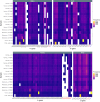Single-cell T-cell receptor repertoire profiling in dogs
- PMID: 38649520
- PMCID: PMC11035579
- DOI: 10.1038/s42003-024-06174-w
Single-cell T-cell receptor repertoire profiling in dogs
Abstract
Spontaneous cancers in companion dogs are robust models of human disease. Tracking tumor-specific immune responses in these models requires reagents to perform species-specific single cell T cell receptor sequencing (scTCRseq). scTCRseq and integration with scRNA data have not been demonstrated on companion dogs with cancer. Here, five healthy dogs, two dogs with T cell lymphoma and four dogs with melanoma are selected to demonstrate applicability of scTCRseq in a cancer immunotherapy setting. Single-cell suspensions of PBMCs or lymph node aspirates are profiled using scRNA and dog-specific scTCRseq primers. In total, 77,809 V(D)J-expressing cells are detected, with an average of 3498 (348 - 5,971) unique clonotypes identified per sample. In total, 29/34, 40/40, 22/22 and 9/9 known functional TRAV, TRAJ, TRBV and TRBJ gene segments are observed respectively. Pseudogene or otherwise defective gene segments are also detected supporting re-annotation of several as functional. Healthy dogs exhibit highly diverse repertoires, T cell lymphomas exhibit clonal repertoires, and vaccine-treated melanoma dogs are dominated by a small number of highly abundant clonotypes. scRNA libraries define large clusters of V(D)J-expressing CD8+ and CD4 + T cells. Dominant clonotypes observed in melanoma PBMCs are predominantly CD8 + T cells, with activated phenotypes, suggesting possible anti-tumor T cell populations.
© 2024. The Author(s).
Conflict of interest statement
The authors declare no competing interests.
Figures







Similar articles
-
Single cell RNA-sequencing of feline peripheral immune cells with V(D)J repertoire and cross species analysis of T lymphocytes.Front Immunol. 2024 Nov 15;15:1438004. doi: 10.3389/fimmu.2024.1438004. eCollection 2024. Front Immunol. 2024. PMID: 39620216 Free PMC article.
-
Identification of a public CDR3 motif and a biased utilization of T-cell receptor V beta and J beta chains in HLA-A2/Melan-A-specific T-cell clonotypes of melanoma patients.J Transl Med. 2009 Mar 24;7:21. doi: 10.1186/1479-5876-7-21. J Transl Med. 2009. PMID: 19317896 Free PMC article.
-
Transcriptomic profiling in canines and humans reveals cancer specific gene modules and biological mechanisms common to both species.PLoS Comput Biol. 2021 Sep 27;17(9):e1009450. doi: 10.1371/journal.pcbi.1009450. eCollection 2021 Sep. PLoS Comput Biol. 2021. PMID: 34570764 Free PMC article.
-
Detection of clonal antigen receptor gene rearrangement in dogs with lymphoma by real-time polymerase chain reaction and melting curve analysis.BMC Vet Res. 2014 Jan 3;10:1. doi: 10.1186/1746-6148-10-1. BMC Vet Res. 2014. PMID: 24383544 Free PMC article.
-
Topology and expressed repertoire of the Felis catus T cell receptor loci.BMC Genomics. 2020 Jan 6;21(1):20. doi: 10.1186/s12864-019-6431-5. BMC Genomics. 2020. PMID: 31906850 Free PMC article.
Cited by
-
A review of CD4+ T cell differentiation and diversity in dogs.Vet Immunol Immunopathol. 2024 Sep;275:110816. doi: 10.1016/j.vetimm.2024.110816. Epub 2024 Aug 21. Vet Immunol Immunopathol. 2024. PMID: 39173398 Review.
-
Single-Cell Antigen Receptor Sequencing in Pigs with Influenza.bioRxiv [Preprint]. 2024 Oct 15:2024.10.13.617920. doi: 10.1101/2024.10.13.617920. bioRxiv. 2024. Update in: Commun Biol. 2025 Jul 26;8(1):1108. doi: 10.1038/s42003-025-08507-9. PMID: 39464079 Free PMC article. Updated. Preprint.
-
Single-cell antigen receptor sequencing in pigs with influenza.Commun Biol. 2025 Jul 26;8(1):1108. doi: 10.1038/s42003-025-08507-9. Commun Biol. 2025. PMID: 40715353 Free PMC article.
-
Translational History and Hope of Immunotherapy of Canine Tumors.Clin Cancer Res. 2024 Oct 1;30(19):4272-4285. doi: 10.1158/1078-0432.CCR-23-2266. Clin Cancer Res. 2024. PMID: 39042399 Free PMC article. Review.
-
Tumor-associated macrophages: Prognostic and therapeutic targets for cancer in humans and dogs.Front Immunol. 2023 Apr 5;14:1176807. doi: 10.3389/fimmu.2023.1176807. eCollection 2023. Front Immunol. 2023. PMID: 37090720 Free PMC article. Review.
References
Publication types
MeSH terms
Substances
Grants and funding
LinkOut - more resources
Full Text Sources
Research Materials

